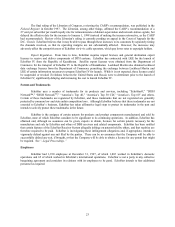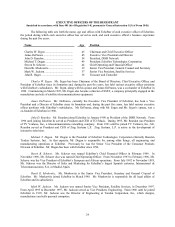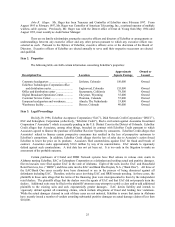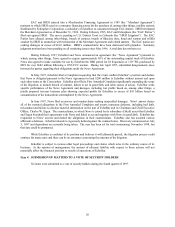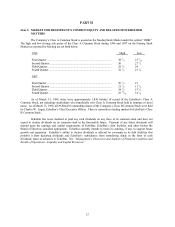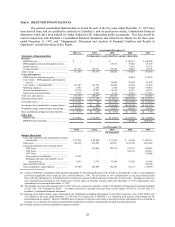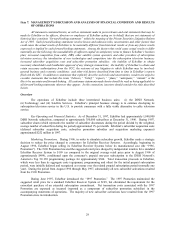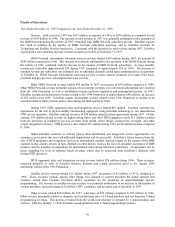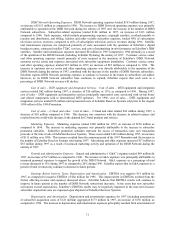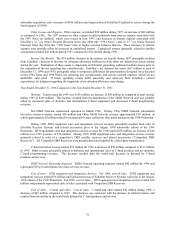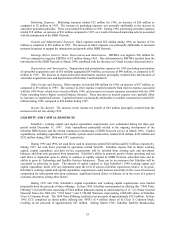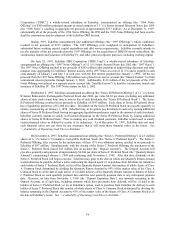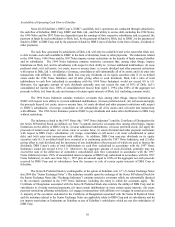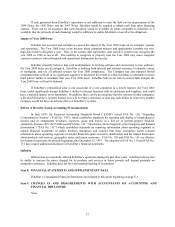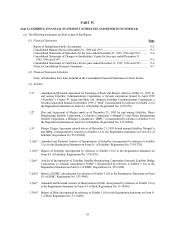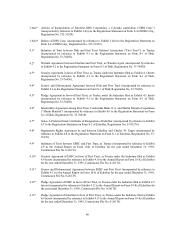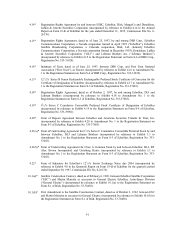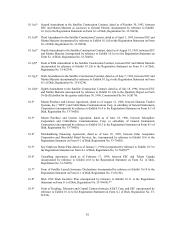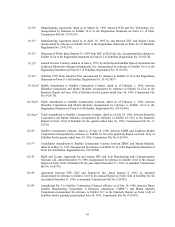Dish Network 1997 Annual Report Download - page 35
Download and view the complete annual report
Please find page 35 of the 1997 Dish Network annual report below. You can navigate through the pages in the report by either clicking on the pages listed below, or by using the keyword search tool below to find specific information within the annual report.33
Marketing Expenses. Marketing expenses totaled $52 million for 1996, an increase of $50 million as
compared to $2 million in 1995. The increase in marketing expenses was primarily attributable to the increase in
subscriber promotion subsidies. These costs totaled $34 million in 1996. During 1996, advertising and other expenses
totaled $18 million, an increase of $16 million compared to 1995, as a result of increased marketing activity associated
with the introduction of the DISH Network.
General and Administrative Expenses. G&A expenses totaled $52 million during 1996, an increase of $16
million as compared to $36 million in 1995. The increase in G&A expenses was principally attributable to increased
personnel expenses to support the introduction and growth of the DISH Network.
Earnings Before Interest, Taxes, Depreciation and Amortization. EBITDA was negative $66 million for
1996 as compared to negative EBITDA of $5 million during 1995. This deterioration in EBITDA resulted from the
introduction of the DISH Network in March 1996, combined with the decrease in C-band revenues discussed above.
Depreciation and Amortization. Depreciation and amortization expenses for 1996 (including amortization
of subscriber acquisition costs of $16 million) aggregated $43 million, an increase of $40 million, as compared to $3
million in 1995. The increase in depreciation and amortization expenses principally resulted from amortization of
subscriber acquisition costs and depreciation of EchoStar I and EchoStar II.
Other Income and Expense. Other expense, net totaled $46 million for 1996, an increase of $37 million, as
compared to $9 million in 1995. The increase in other expense resulted primarily from interest expense associated
with the 1996 Notes, which were issued in March 1996, and increases in interest expenses associated with the 1994
Notes (resulting from a higher accreted balance thereon). These increases in interest expense were partially offset
by increases in capitalized interest. Capitalized interest (principally attributable to satellite construction) totaled $32
million during 1996, compared to $26 million during 1995.
Income Tax Benefit. The increase in the income tax benefit of $49 million principally resulted from the
increase in the net loss during 1996.
LIQUIDITY AND CAPITAL RESOURCES
EchoStar’s working capital and capital expenditure requirements were substantial during the three-year
period ended December 31, 1997. Such expenditures principally related to the ongoing development of the
EchoStar DBS System and the related commercial introduction of DISH Network service in March 1996. Capital
expenditures, including expenditures for satellite systems under construction, totaled $134 million, $222 million and
$232 million during 1995, 1996 and 1997, respectively.
During 1995 and 1996, net cash flows used in operations totaled $20 million and $27 million, respectively.
During 1997, net cash flows provided by operations totaled $43,000. EchoStar expects that its future working
capital, capital expenditure and debt service requirements will be satisfied from existing cash and investment
balances and from cash generated from operations. EchoStar’s ability to generate positive future operating and net
cash flows is dependent upon its ability to continue to rapidly expand its DISH Network subscriber base and its
ability to grow its Technology and Satellite Services businesses. There can be no assurance that EchoStar will be
successful in achieving its goals. The amount of capital required to fund EchoStar’s 1998 working capital and
capital expenditure needs will vary dependent upon the level of success EchoStar experiences relative to its goals.
EchoStar’s working capital and capital expenditure requirements could increase materially in the event of increased
competition for subscription television customers, significant launch delays or failures, or in the event of a general
economic downturn, among other factors.
During 1995 and 1996, EchoStar’s capital expenditure and working capital requirements were funded
principally from the proceeds of three offerings. In June 1994, EchoStar consummated an offering (the “ 1994 Notes
Offering”) of 624,000 units consisting of $624 million principal amount at stated maturity of 12 7/8% Senior Secured
Discount Notes due 2004 (the “ 1994 Notes”) and 3,744,000 Warrants (representing 2,808,000 shares of EchoStar
Class A Common Stock). The 1994 Notes Offering resulted in net proceeds of approximately $323 million. In June
1995, ECC completed an initial public offering (the “ IPO”) of 4 million shares of its Class A Common Stock,
resulting in net proceeds of approximately $63 million. During March 1996, EchoStar Satellite Broadcasting


